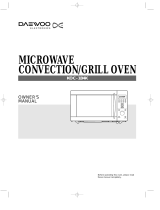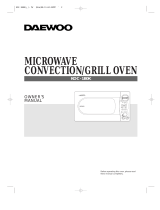
Instructions
46
1 Instructions
IMPORTANT SAFETY INSTRUCTIONS
PLEASE READ CAREFULLY AND RETAIN FOR FUTURE USE.
1.1 General safety instructions
Risk of personal injury
• WARNING: If the door or the
door seal is damaged, the oven
must not be used until it has been
repaired by a competent person.
• WARNING: It is hazardous for
anyone other than a competent
person to carry out any service or
repair operation which involves
the removal of a cover which
offers protection against exposure
to microwave energy.
• WARNING: Liquids and other
foods must not be heated in
sealed containers since they are
liable to explode.
• WARNING: During use the
appliance and its accessible parts
become very hot.
• Never touch the heating elements
during use.
• Keep children under eight years
of age at a safe distance if they
are not constantly supervised.
• This appliance may be used by
children aged at least 8 and by
people of reduced physical and
mental capacity, or lacking in
experience in the use of electrical
appliances, as long they are
supervised or instructed by adults
who are responsible for their
safety.
• Children must never play with the
appliance.
• The appliance must never be
cleaned by unsupervised children.
• Switch off the appliance
immediately after use.
• If smoke is emitted, switch off or
unplug the appliance and keep
the door closed in order to stifle
any flames.
• Never attempt to extinguish a
flame or fire with water.
• Have qualified personnel carry
out installation and assistance
interventions according to the
standards in force.
• Do not modify this appliance.
• Do not insert pointed metal
objects (cutlery or utensils) into the
slots in the appliance.
• Do not try to repair the appliance
yourself or without the intervention
of a qualified technician.
• If the power supply cable is
damaged, contact technical
support immediately and they will
replace it.






















